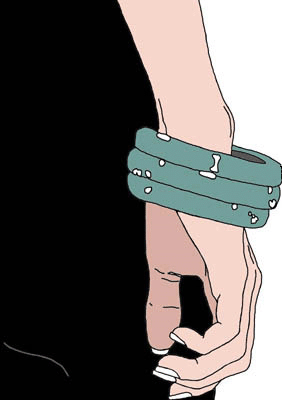
ANOREXIA NERVOSA
Definition
Characterized by failure to maintain a normal body weight, fear and preoccupation with gaining weight, unrealistic self-evaluation as overweight, and amenorrhea for three cycles or more. Subtypes are restricting (no binge-eating or purging) and binge-eating/purging (regularly engaged in binge-eating/purging).
Risk Factors/Etiology
Biologic factors are suggested by higher concordance for illness in monozygotic twins and the fact that amenorrhea may precede abnormal eating behavior. Psychologic risk factors include emotional conflicts concerning family control and sexuality. A cultural risk factor may be an emphasis on thinness.
Prevalence
0,5%. Occurs at a 1:10 male-to-female ratio.
Onset
Average age is 17 years. Very late-onset anorexia nervosa has a poorer prognosis. Onset is often associated with emotional stressors, particularly conflicts with parents about independence, and sexual conflicts.
Key Symptoms
-
Restricted food intake and maintaining diets of low-calorie foods. Weight loss may also be achieved through purging (i.e., vomiting or taking laxatives, diuretics, or enemas) and exercise.
-
Great concern with appearance. Significant amount of time spent examining and denigrating self for perceived signs of excess weight.
- Denial of emaciated conditions.
- With binge-eating/purging: Self-induced vomiting: laxative and diuretic abuse.
Associated Symptoms
Excessive interest in food-related activities (other than eating), obsessive-compulsive symptoms, depressive symptoms.
Course
Some individuals recover after a single episode, and others develop a waxing-and-wanting course.
Outcome
Long-term mortality rate of individuals hospitalized for anorexia nervosa is 10%, resulting from the effects of starvation and purging or suicide.
Physical Examination
Signs of malnutrition include emaciation, hypotension, bradycardia, lanugo (i.e., fine hair on the trunk), and peripheral edema. Signs of purging include eroded dental enamel caused by emesis and scarred or scratched hands from self-gagging to induce emesis. There may be evidence of general medical conditions caused by abnormal diets, starvation, and purging.
Diagnostic Tests
-
Signs of malnutrition: Normochromic, normocytic anemia, elevated liver enzymes, abnormal electrolytes, low estrogen and testosterone levels, sinus bradycardia, reduced brain mass, and abnormal EEG.
-
Signs of purging: Metabolic alkalosis, hypochloremia, and hypokalemia caused by emesis; metabolic acidosis caused by laxative abuse.
Treatment
Initial treatment should be correction of significant physiologic consequences of starvation with hospitalization if necessary. Behavioral therapy should be initiated, with rewards or punishments based on absolute weight, not on eating behaviors. Family therapy designed to reduce conflicts about control by parents is often helpful. Antidepressants may play a limited role in treatment when comorbid depression is present.
Differential Diagnosis
Major rule-outs are bulimia nervosa, general medical conditions that cause weight loss, major depressive disorder, schizophrenia, OCD, and body dysmorphic disorder.
BULIMIA NERVOSA
Definition
Characterized by frequent binge-eating and purging and a self-image that is unduly influenced by weight. Types:
- Purging: Self-induced vomiting or the use of laxatives, diuretics, or enemas.
- Nonpurging: Fasting or exercise, but no purging during bulimic episodes.
Risk Factors/Etiology
Psychologic conflict regarding guilt, helplessness, self-control, and body image may predispose. Biologic factors are suggested by frequent association with mood disorders.
Prevalence
2% in young adult females. Occurs at a 1:9 male-t0-female ratio.
Onset
Usually during late adolescence or early adulthood and often follows a period of dieting.
Course
May be chronic or intermittent.
Outcome
70% of cases have remitted after 10 years. Co-occurring substance abuse is associated with a poorer prognosis.
Key Symptoms
-
Recurrent episodes of binge-eating. Obsession with dieting but followed by binge-eating of high-calorie foods. Binges are associated with emotional stress and followed by feelings of guilt, self-recrimination, and compensatory behaviors.
-
Recurrent, inappropriate compensatory behavior. After a binge, attempts to prevent weight gain through self-induced vomiting, misuse of laxatives, diuretics, enemas, or other medications; fasting; or excessive exercise.
-
Self-evaluation is unduly influenced by body shape and weight. Self-castigation for mild weight gain or binges. Attempts to conceal binge-eating or purging, or lies about behaviors.
Associated Probems
Depressive symptoms, substance abuse, and impulsivity (e.g., kleptomania).
Comorbid Disorders
Borderline personality disorder present in about 50%.
Physical Examination
Evidence of purging.
Diagnostic Tests
Evidence of laxative or diuretic abuse.
Treatment
Cognitive and behavioral therapy are major treatment. Psychodynamic psychotherapies are useful for accompanying borderline personality traits. Antidepressant medications, particularly SSRIs, are usually employed.
Differential Diagnosis
Major rule-outs are anorexia nervosa, binge-eating/purging, major depressive disorder with atypical features, and borderline personality disorder.
REVIEW QUESTION
Case
A 19-year-old woman is hospitalized for dehydration caused by severe, laxative-induced diarrhea. She is depressed about the recent breakup of a romantic relationship. She admits that she uses laxatives because she has been binge-eating frequently and is worried about gaining weight. Although the woman is very thin, she believes that she is overweight. She has never had a menses.
Which of the following is the most likely diagnosis?
- Anorexia nervosa
- Brief psychotic disorder
- Bulimia nervosa
- Deluisional disorder, somatic type
- Major depressive disorder
Answer: A. The patient presents with low body weight, a distorted body image, a fear of obesity, and amenorrhea, all of which strongly suggest anorexia nervosa. Bingeing and purging behavior is commonly present with this disorder. Because this individual has the essential features of anorexia nervosa, the diagnosis of bulimia nervosa is not made. Because the woman shows no evidence of delusions, brief psychotic disorder or delusional disorder are unlikely diagnoses. Although depression commonly accompanies eating disorders, it does not appear to be primary problem in this woman's case.
